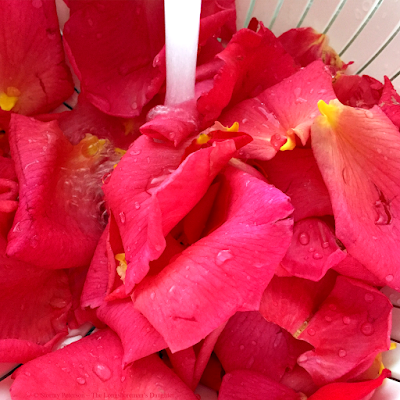FTC Affiliate Disclosure
So, I've already shared with you my Rosy Cheeks Toner recipe, but I kind of glossed over the steps to make your own rosewater at home. Allow me to break down my process:
First things first, I use the simmering technique, because it's faster, easier, and requires fewer supplies and less set-up time. Also, because I use up my rosewater so quickly, I'm not worried about extending the shelf life the way the distillation method can. For more information on the distillation process, check out Sheerin's video for Eve's Cafe, here.
So, I've already shared with you my Rosy Cheeks Toner recipe, but I kind of glossed over the steps to make your own rosewater at home. Allow me to break down my process:
 |
| In this batch: Leaping Salmon & Pink Peace |
To Simmer
Here's what you need:- Rose petals,
- Filtered or previously distilled water,
- Small pot or saucepan with lid,
- Mortar and pestle,
- Mesh strainer,
- 4-cup glass measuring cup,
- Glass bottle, or container for storage
Here's what you do:
Gather a small selection of organically grown, pesticide-free rose petals. Since I'm growing my own, I'm only going to need 2-3 roses with blooms that measure about 4" across. If you're using miniature varieties, you'll obviously need more flowers than this ... This is definitely a "your mileage may vary" kind of project, but as long as you've got a nice little heap of petals, you're good to go!
In a colander (or large mesh strainer) generously rinse rose petals with clean, room-temperature water to remove any dust, film, debris, or little friends that made their way indoors from the garden. Give it a good little jostle to make sure both sides are getting rinsed.
Next, bruise your petals. This can be done any number of ways, I gather them up, and gently mash them with my mortar and pestle. Gently tearing, collecting in a storage bag and pulverizing with a rolling pin, or even meat tenderizing mallet will work just fine. You don't want to bash them beyond recognition, just give them a good massage to encourage them to release their natural oils, and fragrance.
 Place bruised petals in a small pot or saucepan, and fill with just enough pure water to submerge the petals, and cover with lid.
Place bruised petals in a small pot or saucepan, and fill with just enough pure water to submerge the petals, and cover with lid.Over medium-low heat, bring to a simmer, and let your petals luxuriate in their warm bath for 30 minutes, until they have lost their color. Remove from heat, and let cool.
Once cool, using your mesh strainer and glass measuring cup, pour the contents of your pot into the strainer catching the rosewater in the measuring cup below. Be sure to use your pestle, large spoon, or other implement to gently press the wilted petals against the mesh of the strainer to extract as much liquid as possible. You may need to strain a couple of times in case any particles slip through your mesh. When you're finished, store your rosewater in a glass jar or container until you decide what you're going to do with it.
I go straight into making my Rosy Cheeks Toner by combining the following in a Ball® 4 oz. Miniature Storage Jar (simply freezing any leftover rosewater in a tray until I need it for another recipe):
2 oz rose water
10 drops palmarosa essential oil
5 drops lavender essential oil
Witch Hazel's acne-fighting, inflammation, and oil reducing properties coupled with its ability to eliminate bacteria on the skin, and hasten the healing process of skin wounds, and infections partners perfectly with Rosewater's pore tightening, pH balancing, and soothing (to the point of clearing up certain rashes completely) aspects. Adding to that, Palmarosa's skin restorative, regenerative, and rumored anti-wrinkle properties, along with calming Lavender's balancing, and cellular reproduction enhancing effects this concoction creates the perfect team in this cooling astringent. I know people who carry it in little misting bottles for a pick-me-up throughout the day. I store my jar of toner in the refrigerator, and with a little shake to make sure the ingredients are well mixed, and the dip of a cotton ball, my skin gets an extra refreshing Summer treat!
Also! For the gentlemen in your life, Witch Hazel & Rosewater make strong contenders for aftershave ingredients. You may need to butch up the scent a bit by using essential oils other than Palmarosa, and Lavender depending on your guy's taste, but the two to one ratio of the main liquids gives you a great foundation to build from. If you're interested in making products for men at home, and need a little guidance, a couple of good resources to check out are: The Directory of Essential Oils, and Body Care Just for Men.
xoxo

